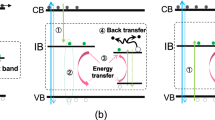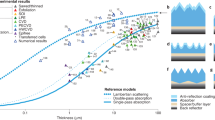Abstract
The intermediate-band solar cell is designed to provide a large photogenerated current while maintaining a high output voltage. To make this possible, these cells incorporate an energy band that is partially filled with electrons within the forbidden bandgap of a semiconductor. Photons with insufficient energy to pump electrons from the valence band to the conduction band can use this intermediate band as a stepping stone to generate an electron–hole pair. Nanostructured materials and certain alloys have been employed in the practical implementation of intermediate-band solar cells, although challenges still remain for realizing practical devices. Here we offer our present understanding of intermediate-band solar cells, as well as a review of the different approaches pursed for their practical implementation. We also discuss how best to resolve the remaining technical issues.
This is a preview of subscription content, access via your institution
Access options
Subscribe to this journal
Receive 12 print issues and online access
$209.00 per year
only $17.42 per issue
Buy this article
- Purchase on Springer Link
- Instant access to full article PDF
Prices may be subject to local taxes which are calculated during checkout




Similar content being viewed by others
References
Luque, A. & Martí, A. A metallic intermediate band high efficiency solar cell. Prog. Photovolt. Res. Appl. 9, 73–86 (2001).
Luque, A. & Martí, A. Increasing the efficiency of ideal solar cells by photon induced transitions at intermediate levels. Phys. Rev. Lett. 78, 5014–5017 (1997).
Shockley, W. & Queisser, H. J. Detailed balance limit of efficiency of p–n junction solar cells. J. Appl. Phys. 32, 510–519 (1961).
Green, A. M. Multiple band and impurity photovoltaic solar cells: General theory and comparison to tandem cells. Prog. Photovolt. Res. Appl. 9, 137–144 (2001).
Wolf, M. Limitations and possibilities for improvements of photovoltaic solar energy converters. Part I: Considerations for earth's surface operation. Proc. IRE 48, 1246–1263 (1960).
Ekins-Daukes, N. J., Honsberg, C. B. & Yamaguchi, M. Signature of intermediate band materials from luminescence measurements in Proc. 31st IEEE Photovoltaic Specialists Conf. 49–54 (IEEE, 2005).
Levy, M. Y. & Honsberg, C. Solar cell with an intermediate band of finite width. Phys. Rev. B 78, 165122 (2008).
Strandberg, R. & Reenaas, T. W. Photofilling of intermediate bands. J. Appl. Phys. 105, 124512 (2009).
Martí, A., Cuadra, L. & Luque, A. Quantum dot intermediate band solar cell in Proc. 28th IEEE Photovoltaics Specialists Conf. 904–943 (IEEE, 2000).
Luque, A. et al. General equivalent circuit for intermediate band devices: Potentials, currents and electroluminescence. J. Appl. Phys. 96, 903–909 (2004).
Marti, A. et al. Elements of the design and analysis band solar of quantum-dot intermediate cells. Thin Solid Films 516, 6716–6722 (2008).
Hubbard, S. M. et al. Effect of strain compensation on quantum dot enhanced GaAs solar cells. Appl. Phys. Lett. 92, 123512 (2008).
Oshima, R., Takata, A. & Okada, Y. Strain-compensated InAs/GaNAs quantum dots for use in high-efficiency solar cells. Appl. Phys. Lett. 93, 083111 (2008).
Kechiantz, A. M., Sun, K. W., Kechiyants, H. M. & Kocharyan, L. M. Self-ordered Ge/Si quantum dot intermediate band photovoltaic solar cells. Int. Sci. J. Alt. Energ. Ecol. 12, 85–87 (2005).
Laghumavarapu, R. B. et al. Improved device performance of InAs/GaAs quantum dot solar cells with GaP strain compensation layers. Appl. Phys. Lett. 91, 243115 (2007).
Zhou, D., Sharma, G., Thomassen, S. F., Reenaas, T. W. & Fimland, B. O. Optimization towards high density quantum dots for intermediate band solar cells grown by molecular beam epitaxy. Appl. Phys. Lett. 96, 061913 (2010).
Blokhin, S. A. et al. AlGaAs/GaAs Photovoltaic cells with an array of InGaAs QDs. Semiconductors 43, 514–518 (2009).
Bailey, C. G., Forbes, D. V., Raffaelle, R. P. & Hubbard, S. M. Near 1 V open circuit voltage InAs/GaAs quantum dot solar cells. Appl. Phys. Lett. 98, 163105 (2011).
Guimard, D. et al. Fabrication of InAs/GaAs quantum dot solar cells with enhanced photocurrent and without degradation of open circuit voltage. Appl. Phys. Lett. 96, 203507 (2010).
Popescu, V., Bester, G., Hanna, M. C., Norman, A. G. & Zunger, A. Theoretical and experimental examination of the intermediate-band concept for strain-balanced (In, Ga)As/Ga(As, P) quantum dot solar cells. Phys. Rev. B 78, 205321 (2008).
Akahane, K. et al. Highly packed InGaAs quantum dots on GaAs(311)B. Appl. Phys. Lett. 73, 3411–3413 (1998).
Datta, S. Quantum Phenomena Ch. 6 (Addison Wesley, 1989).
Luque, A., Marti, A., Antolin, E. & Garcia-Linares, P. Intraband absorption for normal illumination in quantum dot intermediate band solar cells. Sol. Energ. Mater. Sol. C. 94, 2032–2035 (2010).
Luque, A. et al. Radiative thermal escape in intermediate band solar cells. AIP Advances 1, 022125 (2011).
Luque, A. et al. New Hamiltonian for a better understanding of the quantum dot intermediate band solar cells. Sol. Energ. Mater. Sol. C. 95, 2095–2101 (2011).
Tomic, S., Jones, T. S. & Harrison, N. M. Absorption characteristics of a quantum dot array induced intermediate band: Implications for solar cell design. Appl. Phys. Lett. 93, 263105 (2008).
Antolín, E. et al. Reducing carrier escape in the InAs/GaAs quantum dot intermediate band solar cell. J. Appl. Phys. 108, 064513 (2010).
Linares, P. G. et al. Voltage recovery in intermediate band solar cells. Sol. Energ. Mater. Sol. C. 98, 240–244 (2012).
Shockley, W. & Read, W. T. Statistics of the recombination of holes and electrons. Phys. Rev. 87, 835–842 (1952).
Hall, R. N. Electron–hole recombination in germanium. Phys. Rev. 87, 387 (1952).
Wahnón, P. & Tablero, C. Ab initio electronic structure calculations for metallic intermediate band formation in photovoltaic materials. Phys. Rev. B 65, 155115 (2002).
Palacios, P., Wahnón, P., Pizzinato, S. & Conesa, J. C. Energetics of formation of TiGa3As4 and TiGa3P4 intermediate band materials. J. Chem. Phys. 124, 14711–14715 (2006).
Palacios, P., Aguilera, I., Sanchez, K., Conesa, J. C. & Wahnon, P. Transition-metal-substituted indium thiospinels as novel intermediate-band materials: Prediction and understanding of their electronic properties. Phys. Rev. Lett. 101, 046403 (2008).
Sanchez, K., Aguilera, I., Palacios, P. & Wahnon, P. Assessment through first-principles calculations of an intermediate-band photovoltaic material based on Ti-implanted silicon: Interstitial versus substitutional origin. Phys. Rev. B 79, 165203 (2009).
Yu, K. M. et al. Diluted II–VI oxide semiconductors with multiple band gaps. Phys. Rev. Lett. 91, 246403–246404 (2003).
Walukiewicz, W. et al. Interaction of localized electronic states with the conduction band: Band anticrossing in II–VI semiconductor ternaries. Phys. Rev. Lett. 85, 1552–1555 (2000).
Yu, K. M. et al. Multiband GaNAsP quaternary alloys. Appl. Phys. Lett. 88, 092110–092113 (2006).
Lucena, R., Aguilera, I., Palacios, P., Wahnon, P. & Conesa, J. C. Synthesis and spectral properties of nanocrystalline V-Substituted In2S3: A novel material for more efficient use of solar radiation. Chem. Mater. 20, 5125–5127 (2008).
Gonzalez-Diaz, G. et al. Intermediate band mobility in heavily titanium-doped silicon layers. Sol. Energ. Mater. Sol. C. 93, 1668–1673 (2009).
Lang, D. V. & Henry, C. H. Nonradiative recombination at deep levels in GaAs and GaP by lattice-relaxation multiphonon emission. Phys. Rev. Lett. 35, 1525–1528 (1975).
Markvart, T. Multiphonon recombination in Recombination in semiconductors (ed. Landsberg, P. T.) 450 (Cambridge University Press, 1991).
Luque, A., Martí, A., Antolín, E. & Tablero, C. Intermediate bands versus levels in non-radiative recombination. Physica B 382, 320–327 (2006).
Mott, N. F. Metal–insulator transition. Rev. Mod. Phys. 40, 677–683 (1968).
Antolin, E. et al. Lifetime recovery in ultrahighly titanium-doped silicon for the implementation of an intermediate band material. Appl. Phys. Lett. 94, 042115 (2009).
Wang, W., Lin, A. S. & Phillips, J. D. Intermediate-band photovoltaic solar cell based on ZnTe:O. Appl. Phys. Lett. 95, 011103 (2009).
Wang, W., Lin, A. S., Phillips, J. D. & Metzger, W. K. Generation and recombination rates at ZnTe:O intermediate band states. Appl. Phys. Lett. 95, 261107 (2009).
Lopez, N., Reichertz, L. A., Yu, K. M., Campman, K. & Walukiewic, W. Engineering the electronic band structure for multiband solar cells. Phys. Rev. Lett. 106, 028701 (2011).
Luque, A. & Marti, A. Photovoltaics: Towards the intermediate band. Nature Photon. 5, 137–138 (2011).
Antolín, E., Martí, A. & Luque, A. The lead salt quantum dot intermediate band solar cell in Proc. 37th Photovoltaic Specialists Conf. (IEEE, 2011).
Heiss, W. et al. Quantum dot with coherent interfaces between rocksalt-PbTe and zincblende-CdTe. J. Appl. Phys. 101, 081723 (2007).
Harrison, P. Quantum Wells, Wires and Dots 333 (Wiley, 2005).
Barreau, N. et al. Study of a new indium sulphide derivative for buffer layer application in Proc. 29th IEEE Photovoltaic Specialists Conf. 628–631 (IEEE, 2002).
Martí, A. et al. Emitter degradation in quantum dot intermediate band solar cells. Appl. Phys. Lett. 90, 233510 (2007).
Author information
Authors and Affiliations
Corresponding author
Ethics declarations
Competing interests
The authors declare no competing financial interests.
Rights and permissions
About this article
Cite this article
Luque, A., Martí, A. & Stanley, C. Understanding intermediate-band solar cells. Nature Photon 6, 146–152 (2012). https://doi.org/10.1038/nphoton.2012.1
Published:
Issue Date:
DOI: https://doi.org/10.1038/nphoton.2012.1
This article is cited by
-
A Comprehensive Survey of Silicon Thin-film Solar Cell: Challenges and Novel Trends
Plasmonics (2024)
-
Performance optimization of In(Ga)As quantum dot intermediate band solar cells
Discover Nano (2023)
-
Optical Properties of Selenium-Hyperdoped Si Layers: Effects of Laser and Thermal Treatment
Journal of Applied Spectroscopy (2023)
-
First-Principles Study of Antiferromagnetic Superexchange Interactions Between TiAl-VN Complexes in AlN
Journal of Superconductivity and Novel Magnetism (2022)
-
Research on surface phase transformation of NEA GaAs photocathodes during the high-temperature cleaning process
Journal of Materials Science: Materials in Electronics (2022)



